experience a potentially traumatic event by age 16, and experience abuse or neglect.
Without proper attention, these traumatic events can lead to many long-term challenges at all stages of development, from preschool to adulthood. Though each case is unique, common symptoms in children can include anxiety, depression, social isolation, educational and interpersonal struggles, and substance abuse.
Childhood traumatic stress occurs when violent or dangerous events overwhelm a child's or adolescent's coping abilities. What constitutes a potentially traumatic event can encompass many situations, from the especially egregious and horrific to the slightly more common but still traumatizing.
The most serious can be neglect, physical or sexual abuse, natural disasters, witnessing intimate partner violence, and school violence. However, situations that might seem more innocuous can initiate similar trauma responses in a child—from sports injuries to animal bites to having surgery.
Knowing which behavioural indicators of post-traumatic stress to watch for can lead to early treatment, which can have. And so, citing research from the (SAMHSA) and scientific journals, looked at how symptoms of childhood trauma manifest at different age ranges.

Preschool-age children
While the symptoms of trauma in preschool-age children could be difficult to differentiate from some of the common challenges of early childhood, behavioural indicators provided by SAMHSA can help parents, educators, and caregivers know what to look out for.
A traumatic event can cause the body's alarm system—which triggers hormonal responses that tell us to fight, run away, or freeze—to sound off, heightening a child's response to perceived signs of trouble. Those hormonal and emotional reactions can take many forms, from anxiety around parental separation or caregiver to frequent nightmares.
Children who have experienced a traumatic event can also develop difficulties with eating, including weight loss and poor eating habits. When excessive and contextualized with other indicators, frequent crying or screaming—although a common hallmark of childhood—can signal the presence of an early traumatic event.
As different children will recover at different rates, patience, acceptance, and communication are some of the beginning steps to take with a young child experiencing trauma.
Elementary school-age children
As cognitive function increases rapidly during the preschool to elementary school age range, so does the complexity of the body's response to trauma. Moreover, as children enter into the densely social environment of school, the opportunities for trauma responses to express themselves increase.
Emotional regulation is an area of difficulty for elementary school children grappling with PTSD, according to SAMHSA. If a child suddenly becomes excessively anxious or fearful, it can indicate a potentially traumatic event. Feelings of intense guilt or shame are also signs of emotional distress in children of this age, and without the tools to understand them, children often internalize that pressure in terms such as "I'm a bad kid" or "It's all my fault."
Reassuring a child that they are not responsible for the trauma they've experienced is crucial to helping them navigate their complex emotional responses. It's essential to monitor any difficulties with concentration and poor sleep a child may be experiencing, which can also be due to a traumatic event.
Middle school- and high school-age youth
As young people enter a phase of life where higher academic and social standards of performance are often applied, the long-term effects of trauma can have a profound impact.
Feelings of isolation and depression can become internalized and make a person of this age believe no one understands them. Middle and high school is also when they begin to experience greater independence and gain access to less controlled environments.
For people who've experienced a traumatic event, the likelihood of abuse of alcohol or drugs grows. The behind this correlation have been heavily studied. While there are effective means to address these challenges, an important component is to help someone understand that there isn't something wrong with them. Trauma literally .
Without proper guidance, young people of this age are also more likely to develop self-harming behaviours, from suicidal ideation to eating disorders and engaging in risky sexual behaviour.
Childhood trauma in adults
For most individuals, a full recovery from a potentially traumatic event usually arrives after an acute, multi-week period of post-traumatic stress reactions, according to a published in Healthcare. For 6-20% of that population, however, more long-term PTSD symptoms will remain.
As those who have experienced early childhood trauma enter adulthood, numerous challenges can develop if proper care and mitigation have not been provided. These difficulties can manifest interpersonally, academically, and in the form of a significant increase in the risk of developing physical and mental illnesses. A higher likelihood of having anxiety, depression, diabetes, substance use disorders, and heart problems are a few examples.
Various studies have demonstrated that early intervention can be highly successful in reducing these long-term health challenges—so consider seeking the advice of a trained professional, as each person's needs will be unique.
This story originally appeared on and was produced and distributed in partnership with Stacker Studio. Note: Original title was changed to be more evergreen.







